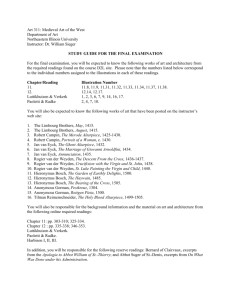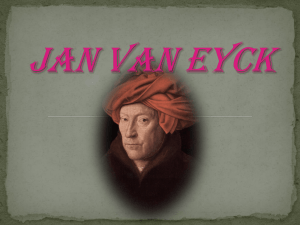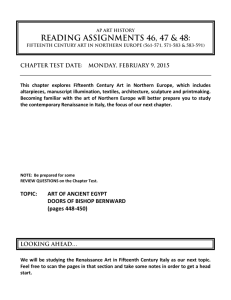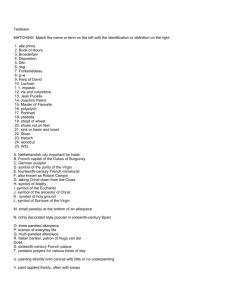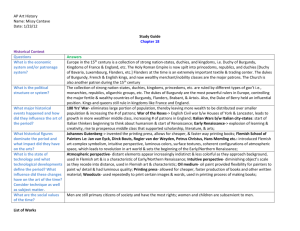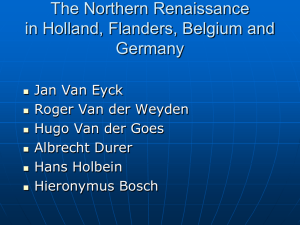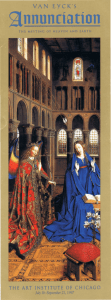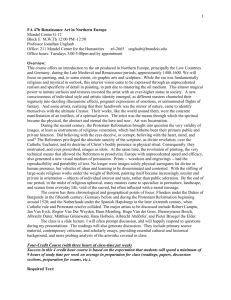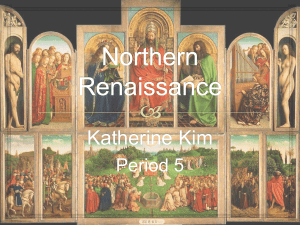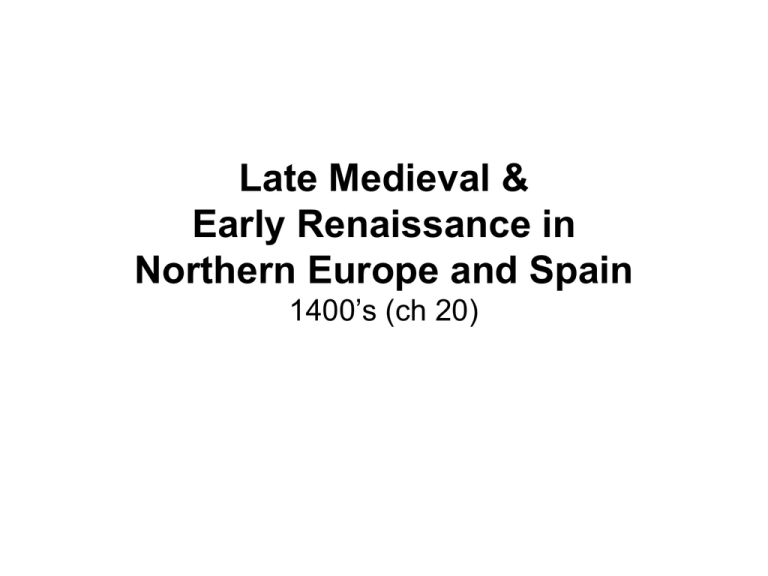
Late Medieval &
Early Renaissance in
Northern Europe and Spain
1400’s (ch 20)
th
15
Famous
c. Flemish Artists
(Netherlandish)
• Jan van Eyck – miniature painting/symbolism/oil paints
• Hugo van der Goes – follower of van Eyck; Portinari
Altarpiece
• Robert Campin – drew from observation
• Rogier van der Weyden
Emotional, pupil of Robert Campin
• Hans Memling
• Limbourg Brothers
Jan Van Eyck (and Hubert van Eyck?)
Ghent Altarpiece (closed)
1432
Oil on Wood
Flemish
Northern Renaissance
•Van Eyck was Philip the Good’s
court painter
•Donors at the bottom
•Ghent’s patron saints Saint John the
Baptist and Saint John the Evangelist
•Annunciation Scene at top
•Tiny Flemish town outside the painted
window of the center panel
•Old Testament Prophets and Sibyls
•http://www.youtube.com/watch?v=zBfM
weJPBrQ what characteristic is unique to
Northern Renaissance paintings?
In the middle is the
Annunciation - the angel
Gabriel, who foretold the
birth of Christ and John the
Baptist, delivers his message
to Mary (right). Her answer
is written upside down for
God to read (not the viewer).
Do unto me what is right, for I
am the handmaiden of the lord.
Jan Van Eyck
Ghent Altarpiece (open)
1432
Oil on Wood
Belgium
Northern Renaissance
•God the Father (wearing the pope’s triple tiara with crown at his feet, lavishly dressed in red)
•Virgin to right (shown as queen of Heaven)
•St. John the Baptist to left
•Choirs of angels on either side
•Adam and Eve on far ends
•http://youtu.be/xwJKfhLMhEk
Above God’s Head: “This is God, all-powerful in his divine majesty; of all the best, by the
gentleness of his goodness; the most liberal giver, because of his infinite generosity.”
•THEME of the piece: SALVATION
- Even though Humans sin (Adam and Eve), God will give salvation because in his infinite love,
he has sacrificed his son for us (bottom panel)
4 items
traditionally
associated with
Christ’s
sufferings:
-cross
-crown of
thorns
-spear
-scourgin pillar
In front of the
altar is the
Fountain of
Life.
Stolen several times (most notoriously during World War II by the Nazis, who hid it in a
salt mine
Jan van Eyck
Giovanni Arnolfini and His Bride
1434
Oil on Wood
Flemish
Northern Renaissance
•Secular art!!!
•Arnolfini, agent of the Medici family
•Flemish bedchamber (spiritual in its simplicity)
•Oranges=fertility, Lemons=well traveled patron
•Clogs=marriage ceremony taking place on holy ground
•Dog=fidelity (fido=Latin to “trust”)
•Mirror=eye of God
•Curtains of marriage bed have been opened
•Finial on bedpost is St. Margaret, patron saint of childbirth
•Whisk broom=domestic tasks
•medallions on mirror frame=scenes of Passion of Christ
•One lit candle=presence of Holy Spirit
•Man near window (worldly), woman near bed (domestic)
•“Jan Van Eyck was here” above mirror, artist seen in mirror
Jan van Eyck
Giovanni Arnolfini and His Bride
1434
Oil on Wood
Flemish
Northern Renaissance
•Secular art!!!
•Arnolfini, agent of the Medici family
•Flemish bedchamber (spiritual in its simplicity)
•Oranges=fertility, Lemons=well traveled patron
•Clogs=marriage ceremony taking place on holy ground
•Dog=fidelity (fido=Latin to “trust”)
•Mirror=eye of God
•Curtains of marriage bed have been opened
•Finial on bedpost is St. Margaret, patron saint of childbirth
•Whisk broom=domestic tasks
•medallions on mirror frame=scenes of Passion of Christ
•One lit candle=presence of Holy Spirit
•Man near window (worldly), woman near bed (domestic)
•“Jan Van Eyck was here” above mirror, artist seen in mirror
Jan van Eyck
Man in a Red Turban
1433
Oil on Wood
Flemish
Early Renaissance
•Economic prosperity led to more secular art
commissions
•Revival of Portraiture
•Possibly a self portrait
•Man looks directly at the viewer … first in
1000 years to do so!
•“As I Can” inscribed at top of frame, “Jan van
Eyck Made Me” at bottom
Limbourg Brothers
Les Tres Riches Heurs du Duc de Berry,
January
1413-1416
Ink on Vellum
Early Renaissance
/ International Gothic
•Three brothers
•Book of Hours (personal prayer book)
•Lunettes above show a chariot racing through
the various zodiac signs of the year
•This shows a new year reception at court.
•Dukes head haloed by fire screen
•His assistant urges guests forward (“aproche”)
•Lavish tapestry (showing Trojan War) and feast
Limbourg Brothers
Les Tres Riches du Duc de Berry,
October
1413-1416
Ink on Vellum
Early Renaissance / International Gothic
•
•
•
Pleasant peasant scene in front of the
Louvre (Kings residence at the time)
Convincing shadows cast by horse and
archer scarecrow (increased interest in
naturalism)
International Gothic style
– 1. charming subject (lighthearted)
because the patronage (the court)
wanted to be amused
– 2. graceful, tall, elegant figures
– 3. cut-away views/high horizon lines
– the artists didn’t want to waste
space and wanted to tell more of
the story – characteristic of the
North to use objects to tell a
story (minute details)
– 4. bright colors, patterns
Less Religious Art, More Secular Art
Rogier van der
Weyden,
Jean Wauquelin
offers his book
to Philip the
Good
Manuscript
Illumination
opaque paint,
gold, pen and ink
on parchment
•Compositionally complex and emotionally charged art
•Meant for a hospital and patient “therapy” (praying)
•Shows patron’s devotion and generosity
•Warned of the fate of people’s souls if they turned away from the Church
•St. Michael weighs souls
•Hierarchy of scale also used to distinguish saved/vs. damned
Rogier van der Weyden
Last Judgment Altarpiece(open)
1444-1448
Oil on Wood
Northern Renaissance
Rogier van der Weyden
Last Judgment Altarpiece (open)
1444-1448
Oil on Wood
Early Renaissance
Rogier van der Weyden
Last Judgment Altarpiece
(open)
1444-1448
Oil on Wood
Early Renaissance
Portinari Altarpiece
•Adoration of the Shepherds in center
•Virgin, Joseph, and angles brood on the suffering to
come
•Humanized Shepherds
•Roman reference in the column
•Iris and Columbine flowers symbolize the Sorrows of
the Virgin
•15 angels=15 Joys of Mary
•wheat stands for Bethlehem
•Harp of David in tympanum=Christ’s ancestry
•Flight into Egypt and Arrival of Magi in background
Hugo van der Goes
Portinari Altarpiece (Open)
1447
Tempera and Oil on Wood
Northern Renaissance / Flemish
Hugo van der Goes
Portinari Altarpiece (Open)
1447
Tempera and Oil on Wood
Early Renaissance
The Virgin of
Chancellor Rolin
1433-34
Jan van Eyck
Hieronymus Bosch
Garden of Earthly Delights
Creation of Eve (left wing), Garden of Earthly Delights (center), Hell (right wing)
1505-1510
Oil on Wood
Northern Renaissance
•Interpretations of Bosch differ widely: satirist? Irreligious mocker? pornographer??
Obsessed with guilt and the universal reign of sin and death?
•This triptych was commissioned for a person’s home
•Displays themes of marriage, sex, and procreation
God presents Eve
to Adam in Eden.
PRINT MAKING
In an intaglio print the image is printed from a recessed design in the
matrix, so that the printmaker creates the matrix by cutting into it the design
he wishes to imprint on the paper.
To create an intaglio print the ink is pressed into the design cut in the matrix,
the surface is wiped, and the ink is then transferred to the paper under
pressure. This process creates the platemark which is the hallmark of an
intaglio print.
Examples of intaglio prints include engravings and etchings.
Platemark
Martin Shongauer
Saint Anthony Tormented by
Demons
1480—1490
Engraving
Northern Renaissance
•Engraving (inscribing on a
hard surface)… reverse of
woodcut
•St. Anthony is stoic as
demons claw at him
•Artist shows cloth, skin,
hair, and scale textures
with variations of line
alone, including hatching
Woodcut: ink covers the raised surfaces
of the plate
Intaglio (engravings and etchings):
ink covers the recessed areas of
the plate

